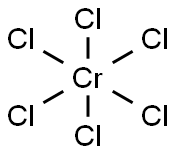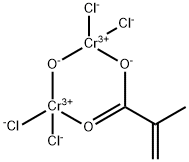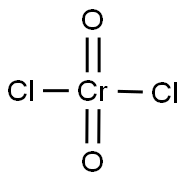CHROMIUM(II) CHLORIDE
Synonym(s):Chromium dichloride;Chromium(II) chloride;Chromous chloride
- CAS NO.:10049-05-5
- Empirical Formula: Cl2Cr
- Molecular Weight: 122.9
- MDL number: MFCD00010947
- EINECS: 233-163-3
- SAFETY DATA SHEET (SDS)
- Update Date: 2025-03-03 09:06:10

What is CHROMIUM(II) CHLORIDE?
Description
Chromous chloride is a white-to-blue solid orlustrous needles which turn blue in water. Molecularweight =122.90; Boiling point =1300℃; Meltingpoint =824℃. Hazard Identification (based on NFPA-704M Rating System): Health 1, Flammability 0, Reactivity 0.Soluble in water.
Chemical properties
grey green powder
Chemical properties
Chromous chloride is a white-to-bluish solid or lustrous needles which turn Blue in water
The Uses of CHROMIUM(II) CHLORIDE
Chromium(II) chloride is used as a precursor to other inorganic and organometallic chromium complexes. It is a reagent in the Nozaki-Hiyama-Kishi reaction. It is also used in the Takai olefination to prepare vinyl iodides from aldehydes in the presence of iodoform.
The Uses of CHROMIUM(II) CHLORIDE
The vapor-phase co-reductions with other metal halides by hydrogen results in finely divided intermetallics with applications as structural materials or compounds with useful thermoelectric, magnetic, and oxidation-resistance properties.
What are the applications of Application
Chromium(II) chloride is used in the condensation of aldehydes with trisubstituted chloroalkenes
General Description
A white crystalline solid. The primary hazard is the threat to the environment. Immediate steps must be taken to prevent its spread to the environment. CHROMIUM(II) CHLORIDE is used to make other chemicals and as an oxygen absorbent.
Air & Water Reactions
Stable in dry air, but oxidizes rapidly in moist air or standing water with liberation of Hydrogen, [Merck, 11th ed., 1989]. Soluble in water.
Reactivity Profile
Inorganic reducing agents, such as CHROMIUM(II) CHLORIDE, react with oxidizing agents to generate heat and products that may be flammable, combustible, or otherwise reactive. Their reactions with oxidizing agents may be violent. Long storage of a CHROMIUM(II) CHLORIDE solution culminated in an explosion. This was ascribed to the slow buildup of hydrogen gas that was produced by reduction of water by the Cr(II) ion [MCA Case History No. 1660].
Health Hazard
DUST: Harmful if inhaled. SOLID: Irritating to skin and eyes. Harmful if swallowed.
Potential Exposure
It is used in metal alloys and metal finishing; textile treatment including mothproofing, waterproofing, printing; and dying, leather tanning; making photographic chemicals; and green pigments for various uses.
First aid
If this chemical gets into the eyes, remove anycontact lenses at once and irrigate immediately for at least15 min, occasionally lifting upper and lower lids. Seek medical attention immediately. If this chemical contacts theskin, remove contaminated clothing and wash immediatelywith soap and water. Seek medical attention immediately. Ifthis chemical has been inhaled, remove from exposure,begin rescue breathing (using universal precautions, including resuscitation mask) if breathing has stopped and CPR ifheart action has stopped. Transfer promptly to a medicalfacility. When this chemical has been swallowed, get medical attention. Give large quantities of water and inducevomiting. Do not make an unconscious person vomit.
Note to physician: In case of fume inhalation, treat pulmonary edema. Consider administering prednisone or othercorticosteroid to reduce tissue response to fume. Positivepressure ventilation may be necessary. Treat metal fumefever with bed rest, analgesics, and antipyretics.
storage
Color Code—Yellow Stripe (strong reducingagent): Reactivity Hazard; Store separately in an area isolated from flammables, combustibles, or other yellow-codedmaterials. Prior to working with chromous chloride youshould be trained on its proper handling and storage. Storein tightly closed containers in a cool, well-ventilated areaaway from water and moisture. Where possible, automatically pump liquid from drums or other storage containers toprocess containers.
Shipping
UN3260 Corrosive solid, acidic, inorganic, n.o. s., Hazard class: 8; Labels: 8-Corrosive material, Technical Name Required.
Purification Methods
It is obtained from the dihydrate by heating in vacuo at 180o. It is a very hygroscopic white powder which dissolves in H2O to give a sky blue solution. It is stable in dry air but oxidises rapidly in moist air and should be stored in air tight containers. It sublimes at 800o in a current of HCl gas and should be cooled in the presence of HCl gas. Alternatively it can be washed with air-free Et2O and dried at 110-120o. [Burg Inorg Synth III 150 1950, Balthis & Bailar (4 H2O) Inorg Synth I 125 1939, Hein & Herzog in Handbook of Preparative Inorganic Chemistry (Ed. Brauer) Academic Press Vol II pp 1336-1338 1965.]
Incompatibilities
Very hygroscopic. The substance is a strong reducing agent. Reacts with oxidizers. Reacts with water, forming flammable hydrogen gas
Properties of CHROMIUM(II) CHLORIDE
| Melting point: | 824 °C(lit.) |
| Boiling point: | 1120°C (estimate) |
| Density | 2.9 g/mL at 25 °C(lit.) |
| storage temp. | Store below +30°C. |
| solubility | soluble in H2O |
| form | powder |
| color | Off-white to green-gray |
| Specific Gravity | 2.878 |
| Water Solubility | Soluble in water. Insoluble in alcohol and ether. |
| Sensitive | Air & Moisture Sensitive |
| Merck | 14,2244 |
| Exposure limits | NIOSH: IDLH 250 mg/m3; TWA 0.5 mg/m3 |
| Stability: | Stable, but decomposes in water or moist air. Incompatible with water, oxidizing agents, active metals. |
| CAS DataBase Reference | 10049-05-5(CAS DataBase Reference) |
| EPA Substance Registry System | Chromium(II) chloride (10049-05-5) |
Safety information for CHROMIUM(II) CHLORIDE
| Signal word | Warning |
| Pictogram(s) |
 Exclamation Mark Irritant GHS07 |
| GHS Hazard Statements |
H302:Acute toxicity,oral |
Computed Descriptors for CHROMIUM(II) CHLORIDE
CHROMIUM(II) CHLORIDE manufacturer
J P Chemicals And Pharma
New Products
1-Boc-4-cyanopiperidine tert-Butyl carbazate 1-(TERT-BUTOXYCARBONYL)-2-PYRROLIDINONE TETRABUTYLAMMONIUM CYANIDE TETRAHYDRO-2H-PYRAN-3-OL 3-Pyridineacrylic acid Nickel(II) perchlorate hexahydrate, 98% 4-Bromophenylacetonitrile, 95% 3-Bromo-4-fluoroaniline, 97% Sodium tetraborate decahydrate, 98% Palladium(II) acetate, trimer, Pd 99% 4-Bromo-2-chlorotoluene, 97% Tadalafil Clopidogrel bisulfate Sitagliptin Phosphate Monohydrate Cabergoline Fexofinadine HCl Etoricoxib 4-Amino Acetophenone 2-Chloro Acetophenone Amlodipine Base 2,3,5-Triiodobenzoic Acid Pyrrolidine Diiodo PentoxideRelated products of tetrahydrofuran








You may like
-
 10049-05-5 Chromium(II) chloride 98%View Details
10049-05-5 Chromium(II) chloride 98%View Details
10049-05-5 -
 Chromium(II) chloride 10049-05-5 98%View Details
Chromium(II) chloride 10049-05-5 98%View Details
10049-05-5 -
 Chromium(II) chloride CAS 10049-05-5View Details
Chromium(II) chloride CAS 10049-05-5View Details
10049-05-5 -
 Chromium(ii) chloride 95% CAS 10049-05-5View Details
Chromium(ii) chloride 95% CAS 10049-05-5View Details
10049-05-5 -
 Chromium(II) chloride CAS 10049-05-5View Details
Chromium(II) chloride CAS 10049-05-5View Details
10049-05-5 -
 Chromium(II) chloride CAS 10049-05-5View Details
Chromium(II) chloride CAS 10049-05-5View Details
10049-05-5 -
 Chromium(II) chloride CAS 10049-05-5View Details
Chromium(II) chloride CAS 10049-05-5View Details
10049-05-5 -
 Chromium(II) chloride CAS 10049-05-5View Details
Chromium(II) chloride CAS 10049-05-5View Details
10049-05-5
